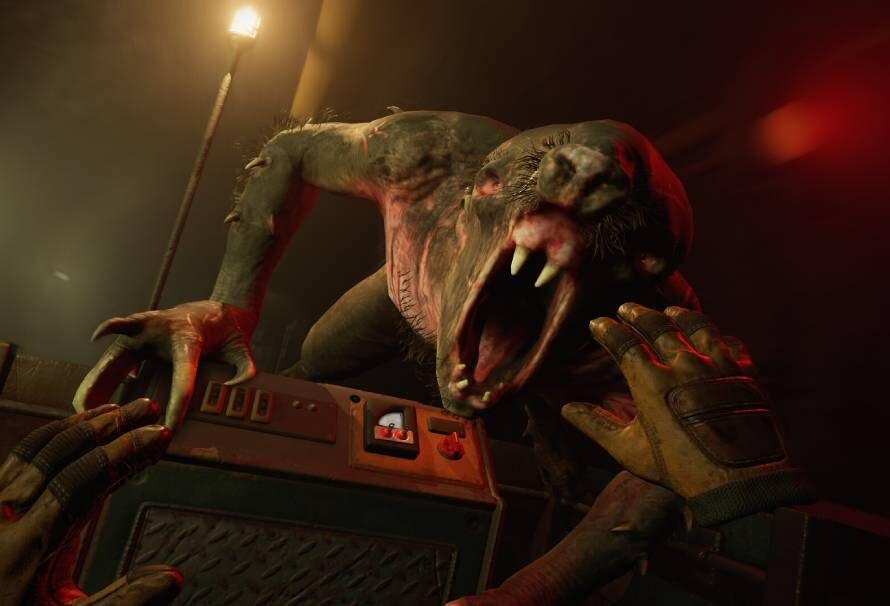Long beloved for its first-person survival horror trappings and stirring depiction of an apocalyptic, devastated Moscow dripping with atmosphere, the Metro series has made an overdue leap to VR and with it comes a range of all-new challenges for adapting such a beloved franchise into an all-new dimension. That said, Metro Awakening has ultimately done a cracking job in adapting many of the classic series elements into this all-new dimension and here’s how developer Vertigo Games has pulled off this rather significant feat.
Atmosphere So Thick You Can Cut It With A Knife
When you think of the Metro games you tend to think of a grim, ruinous world in which the last vestiges of humanity fight a hardscrabble resistance against both each other and an ever-expanding horde of irradiated creatures. With Metro Awakening, Vertigo Games has beautifully transitioned the atmosphere from the traditionally flat 2D stomping grounds of the series into the sort of full three dimensions of immersion that only VR can provide. Not only does Metro Awakening nail the bleak visual grime, shadowy tunnels and lived-in nastiness of the Russian Metro around which Awakening’s story unfurls but so too does the audio work pull you right in, making you jump at the sounds of unseen creatures knocking over pots, pans and other junk in the distance, while when the firearms begin to kick off the aural response is appropriately deafening.

Newly Immersive Physicality
In making the leap to VR, Metro Awakening also makes sure to bolster its toe-curling atmospherics with a sense of physicality that the 2D versions of the game simply cannot match. Whether you’re reloading each clip into your pistol, rejigging your batteries as your torch slowly blinks out in the darkness or putting on your mask and filters to protect yourself from harmful toxins, everything you do in Metro Awakening has a realistic sense of heft and physicality to it. Of course, being a VR title designed from the ground up with the platform in mind, there is an emphasis on performing the right gestures to interact with the game world. In practice, this means that you’ll be reaching over to your shoulders to nab a grenade or a primary firearm, instinctively reaching down to your waist to quickly grab a sidearm or a health-boosting medical syringe and grabbing at spare ammo clips that are fastened onto your chest for easy reloading of whatever gun you happen to have gripped in your virtual hands at the time. Though such control systems are hardly a new thing in the VR gaming space, in Metro Awakening they feel like such an essential part of being immersed in the world that pressing buttons to accomplish the same result just wouldn’t land the same way.
A Handmade Arsenal That Feels And Looks Great In VR
Another aspect of Metro’s long-coded DNA that has successfully made the leap to VR is the handmade arsenal that you’ll be using to dispatch your foes. From pistols that have been stuck together with duct tape to rusty AK-47s, nothing in Metro Awakening looks or feels pristine and that’s exactly how it should be. Additionally, being able to almost forensically examine each weapon and identify every imperfection further underscores the impressive level of visual craft that has gone into bringing every one of these weapons to virtual life.

An All-New Metro Story Steeped In The Series Origins
Rather than just merely adapting an existing Metro title or story into VR, Metro Awakening goes full bore with its own, entirely fresh narrative. Simultaneously both a prequel and a spin-off, Metro Awakening revolves around Serdar, a desperate doctor who must venture into the depths of the Moscow tunnels to locate his wife. Taking place roughly four years before the first Metro game, Metro Awakening’s choice of protagonist is no accident, as it is intended to be an origin story of sorts for series character Khan and ably sets the stage for what he will become in later games. Beyond its lore implications, the story of Metro Awakening also has a sizable impact on how the game plays. Because Serdar is a doctor and not a grizzled soldier, like the protagonists of the other Metro games tend to be, players must make the most of stealthy situations and a dwindling supply of ammo to stay alive. Doom VR, this isn’t and it’s all the better for it.
The Series Trademark Horror Has Never Been So Keenly Felt
Making the most of the immersive opportunities afforded by VR technology, Metro Awakening brings the horror that the series has been known for kicking and screaming into an all-new medium. With the world of Metro Awakening quite literally all around you, the myriad hallucinations coupled with some truly horrific beasts (including a range of grossly gargantuan spiders), all come together to make Metro Awakening one of the most terrifying VR games money can buy. Oh and if you happen to be an arachnophobia sufferer, worry not; developer Vertigo Games has confirmed that it is looking to in an arachnophobia toggle to resolve this in the hopefully near future.

Menus? What Menus
In the leap to VR, one of the biggest and most intriguing ways that Metro Awakening seeks to keep the player thoroughly invested and connected to the world of the earlier Metro games is by curtailing the UI to such an extent that in-game menus are now non-existent. One cool thing that Metro Awakening does is allow players to closely inspect the clip of whatever firearm they have to confirm how much ammo they have left. It certainly feels much more immersive than just staring at an ammo counter in the UI going up or down. Whilst this may sound fairly inconsequential, this is yet another example – and perhaps a prime example – of exactly how perfect the marriage of Metro and VR is and how well it has been accomplished in Metro Awakening.


